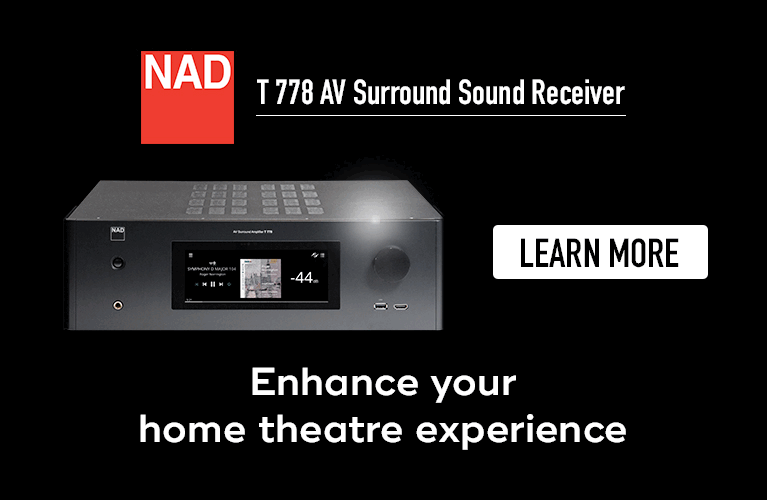Note: Measurements taken in the anechoic chamber at Canada's National Research Council can be found through this link.
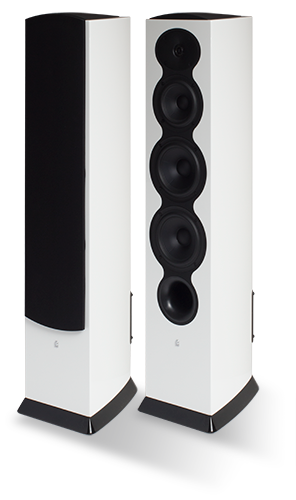
 Revel simultaneously confuses, frustrates, and impresses me. Revel confuses because it’s part of the Harman Luxury Audio Group, the huge, California-based conglomerate that also owns JBL, Mark Levinson, Lexicon, and AKG, among others. Harman’s inner workings remain a mystery to almost everyone outside the company -- and if it’s like the big firms I used to work for, perhaps inside, too. Revel frustrates because, despite being part of such an enormous entity, with access to engineering and manufacturing resources that many can only dream of, it doesn’t produce speakers as often as I’d like -- it seemed like forever between the launch of Revel’s top line, the Ultima models, and the Ultima2s. I’m not sure if it’s because Revel is slow, or because it doesn’t believe it needs to quickly churn out speaker after speaker. And Revel impresses because, when they finally do bring something to market, they usually hit the ball out of the park -- as they did with their Ultima2 Salon2 loudspeaker, which I reviewed in late 2009 and still consider to be one of the very best speakers you can buy near its price ($21,998 USD per pair).
Revel simultaneously confuses, frustrates, and impresses me. Revel confuses because it’s part of the Harman Luxury Audio Group, the huge, California-based conglomerate that also owns JBL, Mark Levinson, Lexicon, and AKG, among others. Harman’s inner workings remain a mystery to almost everyone outside the company -- and if it’s like the big firms I used to work for, perhaps inside, too. Revel frustrates because, despite being part of such an enormous entity, with access to engineering and manufacturing resources that many can only dream of, it doesn’t produce speakers as often as I’d like -- it seemed like forever between the launch of Revel’s top line, the Ultima models, and the Ultima2s. I’m not sure if it’s because Revel is slow, or because it doesn’t believe it needs to quickly churn out speaker after speaker. And Revel impresses because, when they finally do bring something to market, they usually hit the ball out of the park -- as they did with their Ultima2 Salon2 loudspeaker, which I reviewed in late 2009 and still consider to be one of the very best speakers you can buy near its price ($21,998 USD per pair).
Enter the subject of this review: Revel’s floorstanding Performa3 F206 ($3500/pair). Performa3, currently Revel’s mid-level line, also includes a larger floorstander, the F208 ($5000/pair); the stand-mounted M105 ($1500/pair) and M106 ($2000/pair); the C205 ($1000) and C208 ($2000) center-channels; and the S206 surround model ($1800/pair).
Description
When I first saw the Performa3 models, at the 2012 Consumer Electronics Show, it wasn’t love at first sight. In Revel’s overdressed, tacky room at the Venetian, in Las Vegas, the lineup looked, at best, pedestrian. But back home, when I unboxed the F206es and admired their Piano White finish (also available with the M105 and C205, but not with the other Performa3s), I was seriously impressed -- I particularly liked the white finish’s contrast with the shiny black plinth, and the curved, matte-black top panel and baffle. The finish was flawlessly smooth -- no hint of orange peel anywhere. The F206 is also available in Piano Black and High Gloss Walnut, as are all the other models (except the S206, which comes only in Matte Black, probably because surround speakers almost always end up tucked away behind the seating area). All of which made me conclude that the Performa3s hadn’t been properly showcased at CES 2012.
Like the Ultima2 models, the Performa3s have wooden cabinets with rounded sides and rears, which internally helps control standing waves, and gives the speakers a more svelte appearance than the usual rectangular box. The cabinet is made by bending and then gluing together layers of wood, which also increases its stiffness. The F206 measures 41.4”H x 9.8”W x 13.7”D and weighs 58 pounds -- considerably smaller and lighter than the F208 (46.5”H x 11.8”W x 14.8”D, 80 pounds) and the Ultima2 floorstanders, which you’d expect given the price differences.
I have just two criticisms of the F206’s look and build, and they’re little ones. First, I wasn’t enthralled with the spikes -- simple black-anodized jobs that screw into the base of the plinth, and are themselves threaded for thick, black-anodized height-adjustment rings. They do the job well enough, but it’s been the fashion of late to offer more elaborate footers that are often much thicker and have a chrome-like exterior, if only to give a higher quality of finishing. The other has to do with the bolts that hold the drivers in place; small and black, they’re discreet, but you can still see them when the magnetically attached grilles are removed. The trend today is to design a speaker’s front baffle such that the mounting hardware is completely hidden -- Bowers & Wilkins, Monitor Audio, PSB, and others do this, and it looks clean. But as I said, these are little criticisms.
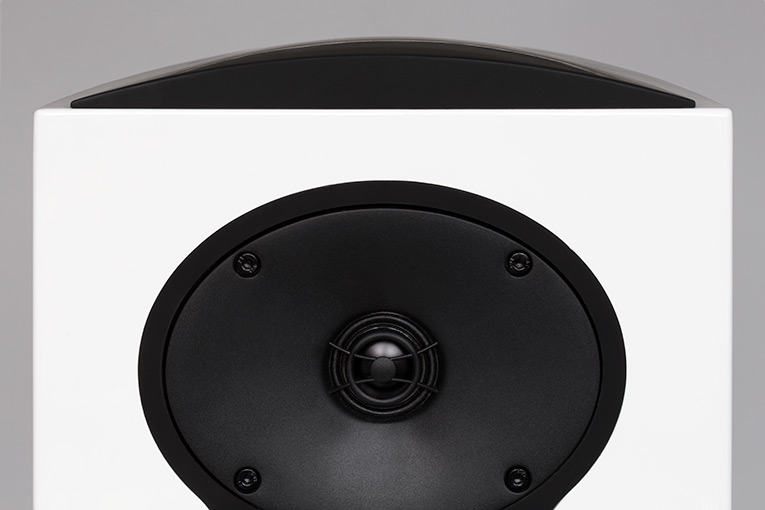
Like the Ultima2 Studio2 ($15,998/pair) and Performa3 F208, the F206 is a four-driver, three-way design (the Ultima2 Salon2 is a four-way with six drivers). Handling the F206’s highs is a 1” aluminum-dome tweeter nestled into what the company calls an Acoustic Lens Waveguide, which increases its sensitivity a bit, but is mostly there for a better acoustic blend with the midrange, which has a 5.25” aluminum cone and a cast basket. (The same two drivers are used in the F208.) Below the tweeter and midrange are two 6.5” woofers (the F208 has 8” woofers), again with aluminum cones and cast baskets. Augmenting the woofers’ output is a large, flared port, located directly below the bottom woofer. A foam port plug is supplied to reduce bass output, but I doubt most will use it -- the F206’s bass wasn’t boomy or overblown, and I doubt a pair of them will overload most typical rooms. The woofers are crossed over to the midrange at 275Hz, and the midrange to the tweeter at 2150Hz.
Around back is a single set of binding posts -- single-wiring is the only option. In contrast, the F208 has two sets of posts, to permit biwiring or biamping. The ability to biwire or biamp is important for some, but has never been for me -- I prefer to use a single pair of good-quality speaker cables, and just one amp. Even when I review speakers that permit biamping/biwiring, I always put the jumpers in and single-wire.
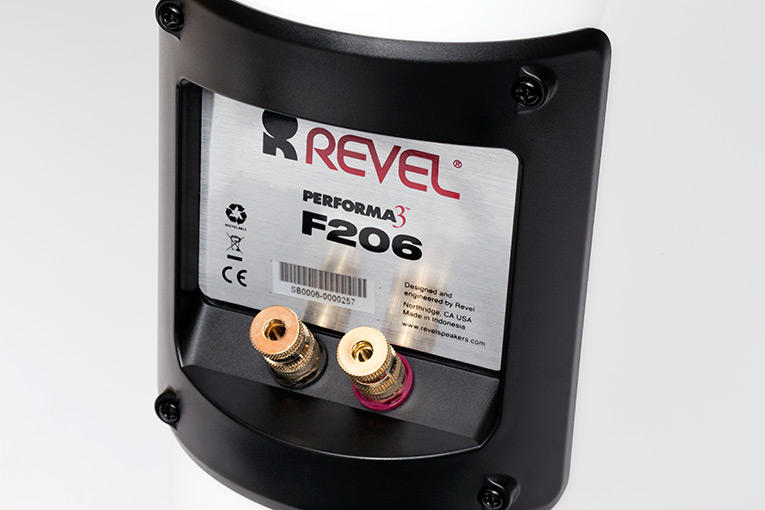
Measurements and specifications are important to Revel. The company has behind it decades of research that correlate meaningful measurements -- in particular, a speaker’s frequency response measured on and off the axis of its drivers -- with listening preferences. These measurements, combined with rigorous blind tests, are ultimately what determine whether or not a Revel prototype goes into production, and might explain why it takes them a long time to bring new models to market. This kind of approach dates back to Dr. Floyd Toole’s research at Canada’s National Research Council (NRC), which is no coincidence. In the 1990s, Toole left the NRC to lead product development at Harman, and continued there until his retirement in 2007.
According to Revel’s specifications, the F206’s -10dB low-frequency limit is 30Hz, and its -6dB limit is 36Hz. These give an idea of the kind of bass depth you can expect in a typical listening room. The claimed -3dB upper-frequency limit is 42kHz. Strangely absent is the deviation between the extremes, on and off axis -- the plus-or-minus stuff. I know that Revel has this kind of data (and much more), but maybe they didn’t want to bore consumers with the hardcore technical details. Revel claims for the F206 a nominal impedance of 8 ohms, which is typical, and a sensitivity of 88dB/2.83V/m, which is average.
Systems
As I did with the last speaker I reviewed, the Bowers & Wilkins 684 S2, I used the F206es with reference-caliber electronics worth tens of thousands of dollars; in this case, a Luxman C-900u preamp, an EMM Labs DAC2X digital-to-analog converter, and a Hegel Music Systems H30 power amplifier. I also paired them with a moderately priced integrated amplifier with a built-in DAC: Hegel Music Systems’ H80, an extremely good model that costs $2000 and is specced to output 80Wpc into 8 ohms -- a more realistic pairing for a $3500 pair of speakers.
The sonic results with these two sets of electronics were slightly different, as you’d expect given the vast price differences, but were also consistent -- the sound didn’t vary drastically from system to system, which will be a relief to those who don’t want to spend a fortune on electronics. I’ll describe some subtle differences between these systems below, but will elaborate here on the big one: power.
The Hegel H30, which puts out 350Wpc into 8 ohms in comparison to the H80’s 80Wpc, resulted in higher volume levels with the F206es, and more headroom for dynamic swings. As a result, with the H80, I couldn’t get “Would You Fight for My Love?” and “High Ball Stepper,” from Jack White’s Lazaretto (16-bit/44.1kHz FLAC, Third Man/Columbia), to rock out as loudly and effortlessly in my room as they did with the H30. The H80 never clipped, but I sensed some strain when I pushed it to extreme volume levels. But the H80’s 80Wpc were certainly enough for above-average volume levels, and likely would please those with the small to midsize listening rooms that are anyway more appropriate for a speaker of this size. But if you do go for more muscle, don’t think you have to reach for anything nearly as powerful as the H30. The F206 can play loud, but not as ultraloud as, say, the Salon2 -- I tapped out the speakers before I strained the H30. Revel recommends amplification of 50-200W for the F206; I think they’re on the money.
Sound
As much as I enjoyed how the F206es looked in my room, I was taken aback by how they sounded, regardless of which electronics I used with them. In fact, I was floored. Right off the bat, the F206’s midrange grabbed me -- it didn’t only sound very natural and neutral, in a typical Revel kind of way (the midband in all Revel speakers is exceedingly linear), but also so startlingly clear that I had a hard time believing that these speakers could cost only $3500/pair -- it was the kind of sound I expect from speakers costing much, much more. The voices of Leonard Cohen, Sade Adu, Van Morrison, and Greg Keelor -- all of which I know well because I play them through every speaker I review -- sprang from the F206es completely unfettered. They sounded so natural, detailed, and realistic that I was immediately reminded of PSB’s Synchrony One, which I raved about five years ago, and Definitive Technology’s Mythos ST-L, which Roger Kanno has just praised on SoundStage! Access (I have a pair of ST-Ls here). Both of those speakers present the midrange unbelievably well and, like the F206, can be compared in that regard to speakers costing far more. Both do cost more than the F206 -- the One now goes for $5500/pair, the ST-L $5000/pair -- so you can understand why I was astonished by what I heard from the Revels.
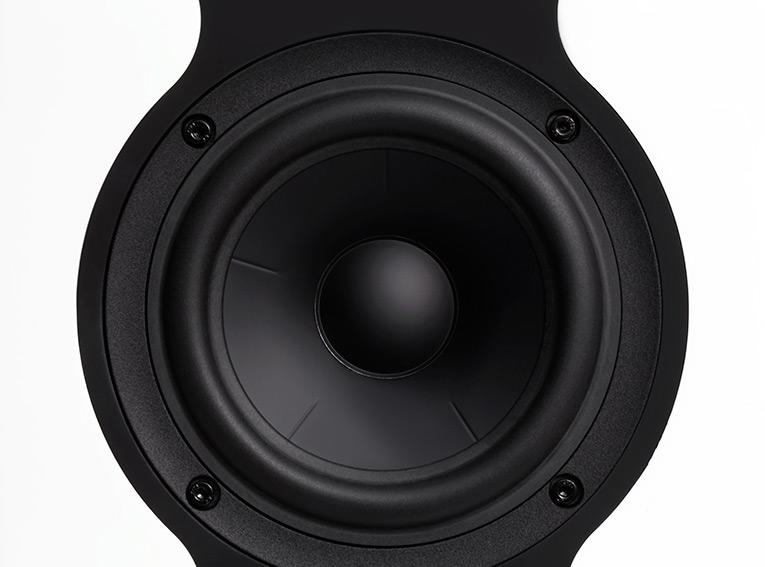
Yet the F206 didn’t display magic in only the midband. From top to bottom, its sound was extraordinarily even overall -- neutral -- and exceptionally detailed throughout the audioband, including in the bass, which I’ve often found a bit boomy and indistinct in affordable floorstanders. It was also tremendously extended in the highs, yet without the “bite” I’ve heard from some metal-dome designs in this price class; and the outputs of the four drivers cohered so well that they sounded as if they were a single driver. Color me impressed by the F206’s lack of coloration.
That coherence I just mentioned is not an insignificant quality -- even many high-priced speakers can’t get it right. The boomy bass of some affordable floorstanders can add fullness, but it doesn’t necessarily blend with the rest of the drivers -- the overall sound can be a bit disjointed. And even in some very expensive speakers, the “blend” of the drivers’ outputs can be anything but. I believe that’s why some people like two-ways so much, even low-cost ones, despite their obvious limitations of having little bass -- all else being equal, it’s a simpler job to coherently blend the outputs of only two drivers. But some designers can successfully blend three or more drivers, which Revel proved to me with their four-way Ultima2 Salon2, whose six drivers blend as well as the F206’s four: in short, seamlessly.
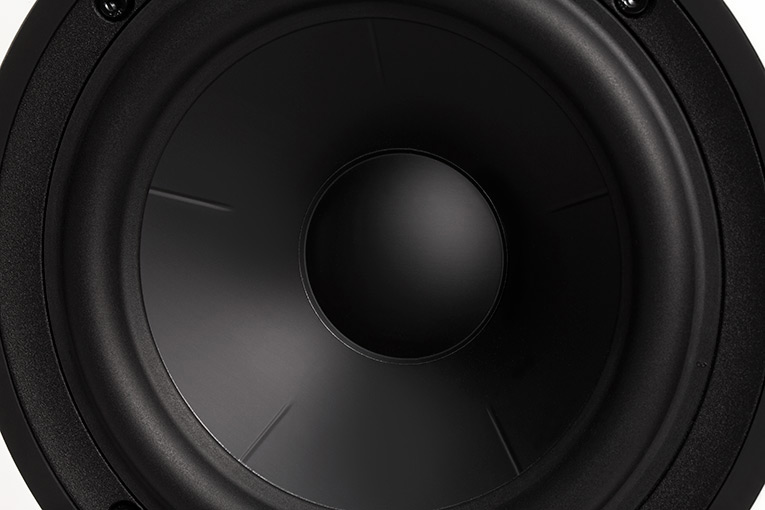
The coherence of the F206es’ driver outputs and the evenness of the speakers’ sound both on and off axis contributed to the expansive soundstages and precise images I heard in my room. These differed a little depending on which electronics I was using, but were always exceptional. With the Hegel H80 in the loop, images were highly defined on stages that, depending on the recording, extended to each speaker’s outer edge, and with depth that was consistently good, if not on a par with the very best. With the more expensive electronics, which are able to reveal more of what my recordings contain, the imaging became a touch more specific, and the stages of recordings that contained such information extended slightly beyond the outer limits of the speakers. Most impressive was that the depth improved markedly -- in this regard, the F206es were up there with the very best speakers I’ve heard at any price. This proved to me that it wasn’t the speakers that were limiting the stage, but the electronics.
For example, when I played the soundtrack to the film The Mission (16/44.1 FLAC, Virgin), the breadth and depth of soundstage equaled what the Polymer Audio Research MKSes had portrayed in my room. The Polymers are stellar in that regard -- and cost $42,000/pair. When I played tracks dominated by singers, such as “Long Road Home,” from Sade’s Soldier of Love (16/44.1 FLAC, Epic), Sade Adu’s voice hung as solidly and tangibly in space as it had through the Magico S5s, which I reviewed late last year and which cost some $30,000/pair. As I reveled in the Revels’ precise, expansive soundstage, the word that kept running through my mind was awesome.
Comparisons
All of this paints a picture of an accomplished loudspeaker -- and for its price, the F206 was just that. But, as with any loudspeaker, there were limitations, particularly when I compared it with speakers that are larger and/or cost more. For example, the F206’s bass extended as low as that of competitors of similar size and price, such as PSB’s Imagine T2 ($3500-$3850/pair), which I reviewed a couple of years ago. It also seemed to be somewhat tighter in the bass than the T2, regardless of which electronics I used. But it didn’t go as low as Definitive Technology’s Mythos ST-L, thanks mostly to the latter’s self-powered, DSP-controlled bass section, which delivers usable response from its main driver and passive radiators to below 30Hz -- really deep. However, the DefTech costs just over one-third more than the Revel. A fairer comparison would probably be between the ST-L and Revel’s own F208, which I obviously can’t make.
Likewise, the F206’s top end was extended and as clean as, if not cleaner than, the T2’s, the Synchrony One’s, or the ST-L’s, which is notable given that two of those speakers cost considerably more. In fact, when I drove the F206es with the pricier electronics, I was consistently surprised by how refined its top end was -- there was no hint of hardness or edge that made me feel as if I were listening to a pair of speakers costing under $10,000. But, ultimately, the F206’s top end wasn’t as sweet as, say, the better beryllium-dome tweeters now on the market, and which Revel reserves for its pricey Ultima2 models.
Finally, due to the modest sizes of its cabinet and drivers, the F206, like the Imagine T2, couldn’t produce ultra-high SPLs or large-scale dynamics the way bigger speakers with bigger woofers can -- the former just can’t move as much air. For that, you might want to look to the F208.
Conclusion
Good things come to those who wait. Though Revel speakers take some time to come to fruition, the results aren’t merely good -- in the case of the Performa3 F206, they’re great. Its strengths are considerable: an exceptionally neutral balance across the audioband; excellent soundstaging and imaging that can compare to speakers at any price; and dazzling clarity in the midrange on a par with speakers costing much more. Understandably, the F206’s few limitations have mainly to do with its modest size and price: Unlike some larger, more expensive speakers, its bass doesn’t extend to the bottom octave, and it isn’t capable of large-scale dynamic swings or super-loud SPLs.

But if I had $3500 to spend on a pair of speakers right now, I’d buy a pair of Performa3 F206es over all others -- I love the speaker’s top-to-bottom neutrality, and especially its magical midrange, which did something special with voices. I also liked the way the review pair looked in my room, and appreciated the topnotch quality of their build and finish. And even if I had upward of $5000, this speaker would be on my very short list of the best of breed at that price -- it punches way above its asking price. With the Performa3 F206, Revel has, once again, knocked one out of the park.
. . . Doug Schneider
das@soundstagenetwork.com
Associated Equipment
- Loudspeakers -- Definitive Technology Mythos SuperTower ST-L
- Power amplifier -- Hegel Music Systems H30
- Integrated amplifier -- Hegel Music Systems H80
- Preamplifier -- Luxman C-900u
- Digital-to-analog converter -- EMM Labs DAC2X
- Computer -- Samsung laptop running Windows 7 and JRiver Media Center 18
- Digital interconnects -- AudioQuest Carbon USB
- Analog interconnects -- Crystal Cable CrystalConnect Standard Diamond
- Speaker cables -- Siltech Classic Anniversary 330L
Revel Performa3 F206 Loudspeakers
Price: $3500 USD per pair.
Warranty: Five years parts and labor.
Revel
Harman Luxury Audio Group
8500 Balboa Blvd.
Northridge, CA 91329
Phone: (888) 691-4171, (203) 328-3500
Website: www.revelspeakers.com






















